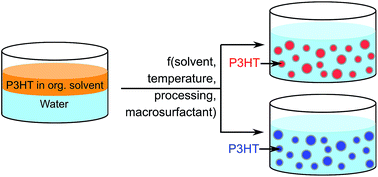Here we demonstrate that the use of macrosurfactants in the production of poly(3-hexylthiophene) (P3HT):water dispersion allows to drastically change the semiconductor's molecular aggregation, leading to pronounced H- or J-like behaviour depending on the macrosurfactant used and the conditions selected to produce the dispersions. No correlation with the particle size and optical response is found, indicating that it is the pre-assembly in the initial emulsion and possibly additional features such as the thermoresponsiveness of one of the macrosurfactants that lead to the specific molecular arrangement of the P3HT. Considering the broad variety of macrosurfactants that can be synthesised based already on the building blocks (co-polymer units) used here, it is clear that this approach can widen the tool box towards structural control of organic semiconductors, and macromolecular materials especially.
